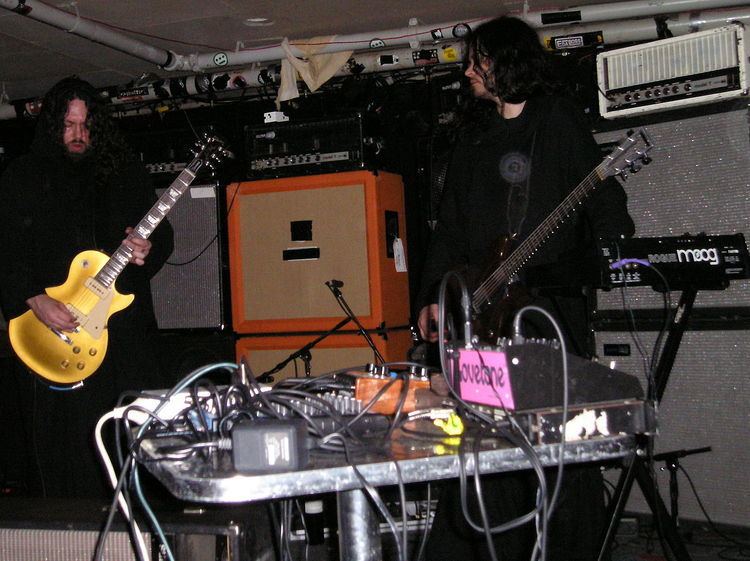 | ||
Stylistic origins Doom metaldroneavant-garde metal Cultural origins Early 1990s, Seattle, Washington | ||
Drone metal (also known as drone doom and power ambient), is a style of heavy metal that melds the slow tempos and heaviness of doom metal with the long-duration tones of drone music. Drone metal is sometimes associated with post-metal or experimental metal.
Contents
Characteristics
Typically, the electric guitar is performed with a large amount of reverb or audio feedback while vocals, if present, are usually growled or screamed. Songs often lack beat or rhythm in the traditional sense and are typically very long. The experience of a drone metal performance has been compared to listening to an Indian raga in the middle of an earthquake by novelist John Wray in The New York Times. Wray also states, "It's hard to imagine any music being heavier or, for that matter, very much slower." A pioneer band of drone metal called Sunn O))) has indicated a kinship with sound sculpture. Jan Tumlir indicates a "sustained infra-sound rumble of sub-bass–-so-called brown noise".
Musical influences
Drone metal music blends elements from a variety of musical influences, including rock/metal artists such as Black Sabbath, Sleep, and Swans, the feedback-heavy guitar tones of Neil Young and Thurston Moore, and minimalist composers such as Phill Niblock, Charlemagne Palestine, La Monte Young, and Tony Conrad, and the multiple guitar compositions of Rhys Chatham and Glenn Branca.
Connections with other art forms
Stephen O'Malley from Sunn O))) collaborated on an installation with artist Banks Violette, who has likened drone metal to the work of Donald Judd. Tumlir locates a precedent in Robert Rauschenberg. Violette points out, however, that drone metal is "as much a physiological phenomenon as an acoustic one", with an attendant physicality. O'Malley has also mentioned an appreciation for Cormac McCarthy and Richard Serra. Rhys Chatham's Essentialist included projections by Robert Longo. Jim Jarmusch's 2009 film The Limits of Control features music by a number of drone metal groups. Jarmusch said, "I love these kind of visual landscapes they make, and they really inspired things for me for my film ..., because when I write I'm listening to things that inspire me in the direction of whatever world I'm imagining. Boris and Sunn O))) and Earth were really instrumental in me just finding a place in my head."
1990s
Drone metal was first established by Earth, a group from Seattle, formed in 1990, which has been described as "minimalist post-grunge". Earth took inspiration from the sludge metal of Melvins and the minimalist music of La Monte Young, among other sources. Stephen O'Malley's group Burning Witch, formed five years later, also in Seattle, continued in this tradition, incorporating unusual vocals and bursts of audio feedback. The group initially recorded for the prominent powerviolence label Slap-a-Ham. O'Malley's subsequent group, Sunn O))), initially formed as a tribute to Earth, is most responsible for the contemporary prominence of the drone metal style. Godflesh is also a stated influence on many groups. Boris, from Tokyo, also developed a style of drone metal, parallel with the Seattle groups, as did Corrupted, from Osaka.
2000s
Nadja (Toronto), Jesu (UK), Black Boned Angel (Wellington, New Zealand), Khanate (New York City), Ocean (Portland, Maine), Growing (New York City), KTL (Washington/London), Ascend and Eagle Twin (USA), Teeth of Lions Rule the Divine (Nottingham, England), Conan (Liverpool, England) and Moss (Southampton, England) are prominent drone metal groups that formed in the early 21st century. Noise musicians, such as Kevin Drumm and Oren Ambarchi, have also worked in the style. Rhys Chatham's Essentialist project is a contribution to drone metal by an elder composer, attempting to "arrive at an a priori essence of heavy metal, reducing it to a basic chord progression".
